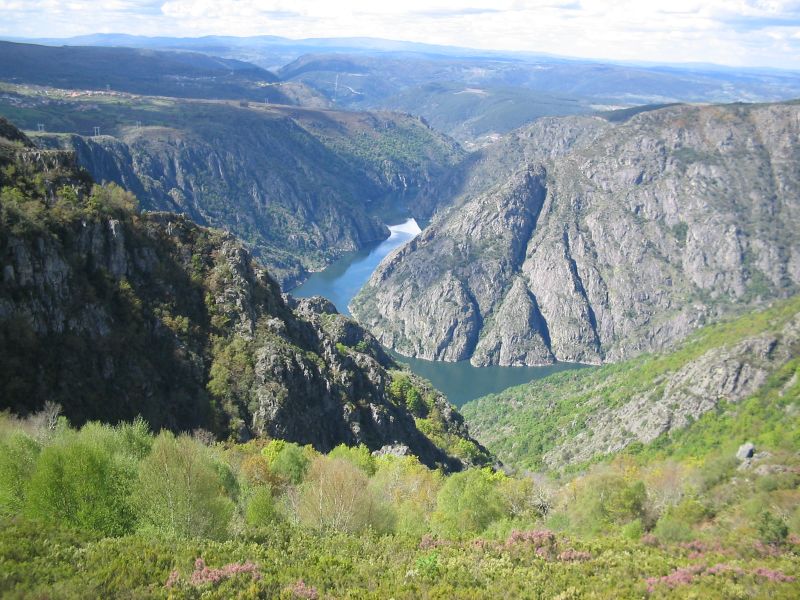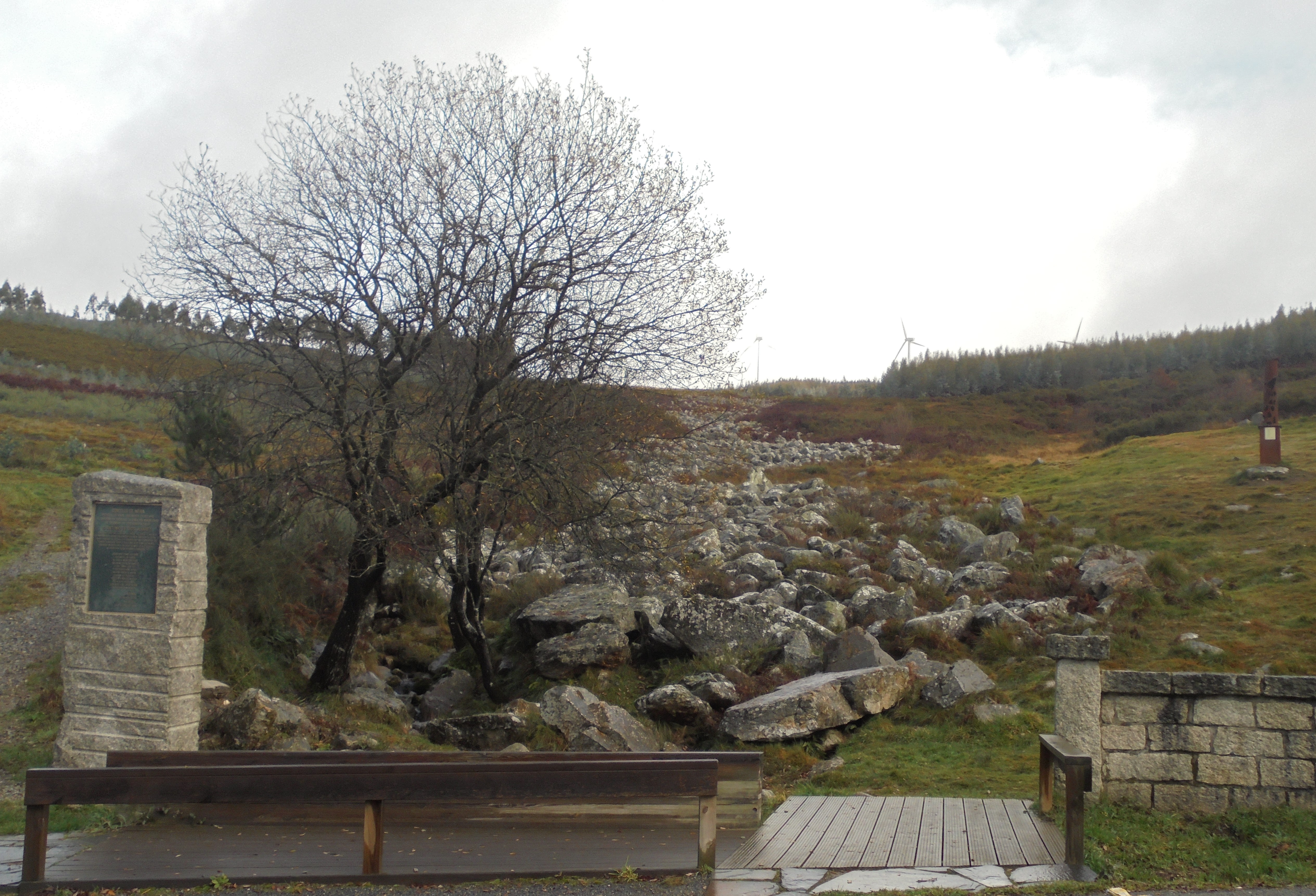|
Sil Canyon
The Sil Canyon ( gl, Canón do Sil) is a gorge in Galicia, Spain along the Sil. It covers the last 50 km before the Sil enters the Minho. The scenery is considered to be the most spectacular in Galicia.Canon de Rio Sil Rough guides The walls rise almost vertically up to 500 m from water level. Due to the extraordinary terrain, the local climate differs from surrounding areas and allows the growth of Mediterranean vegetation, such as olive trees. The river cliffs have been terraced to allow production of grape vines. Wine production started in this area already in Roman times. The area is called the Ribeira Sacra wine region, and it is the only place in Galicia that produces more red than white wine. The gorge is classified in |
Galicia
Galicia may refer to: Geographic regions * Galicia (Spain), a region and autonomous community of northwestern Spain ** Gallaecia, a Roman province ** The post-Roman Kingdom of the Suebi, also called the Kingdom of Gallaecia ** The medieval Kingdom of Galicia ** The Republic of Galicia, which only lasted for a few hours on 27 June 1931 * Galicia (Eastern Europe), a historical region in southeastern Poland and western Ukraine ** The Kingdom of Galicia–Volhynia or Kingdom of Rus, a medieval kingdom ** The Kingdom of Galicia and Lodomeria, a crown land of the Austrian Empire and later the Austrian half (Cisleithania) of Austria-Hungary ** West Galicia or New Galicia, a short-lived administrative region of the Austrian Empire, eventually merged into the Kingdom of Galicia and Lodomeria ** The District of Galicia, part of the Nazi General Government during the World War II occupation of Poland Named after Spanish Galicia * Galicia, Aklan, a barangay in Panay, Philippines * Nueva ... [...More Info...] [...Related Items...] OR: [Wikipedia] [Google] [Baidu] |
Galicia, Spain
Galicia (; gl, Galicia or ; es, Galicia}; pt, Galiza) is an autonomous community of Spain and historic nationality under Spanish law. Located in the northwest Iberian Peninsula, it includes the provinces of A Coruña, Lugo, Ourense, and Pontevedra. Galicia is located in Atlantic Europe. It is bordered by Portugal to the south, the Spanish autonomous communities of Castile and León and Asturias to the east, the Atlantic Ocean to the west, and the Cantabrian Sea to the north. It had a population of 2,701,743 in 2018 and a total area of . Galicia has over of coastline, including its offshore islands and islets, among them Cíes Islands, Ons, Sálvora, Cortegada Island, which together form the Atlantic Islands of Galicia National Park, and the largest and most populated, A Illa de Arousa. The area now called Galicia was first inhabited by humans during the Middle Paleolithic period, and takes its name from the Gallaeci, the Celtic people living north of the Douro River ... [...More Info...] [...Related Items...] OR: [Wikipedia] [Google] [Baidu] |
Sil (river)
The Sil is a river in León (Castile and León) and Galicia, Spain, a tributary of the Miño. Its total length is . The source of the Sil is in the Cantabrian Mountains in the Leonese town of Villablino. It flows through the provinces of León and Ourense. The largest city on the Sil is Ponferrada (León). The Sil flows into the Miño upstream from Ourense. Mouth The river joins the Miño river in Os Peares, in the province of Ourense. Generally, the hierarchy between rivers is performed by taking into account which junction has more volume and length. In this case, as with the Esla and Pisuerga with the Duero, the Sil has flows larger than the Miño at the junction. There is a saying that goes, "The Miño has the fame, but the Sil gives it water" (in Spanish, ''El Miño lleva la fama y el Sil le da el agua''). The Sil river also surpasses the Miño in length by about . Course The Sil runs through the León districts of Babia, Laciana, El Bierzo and La Cabrera, and Oure ... [...More Info...] [...Related Items...] OR: [Wikipedia] [Google] [Baidu] |
Minho (river)
The Minho ( , ) or Miño ( , , ; cel-x-proto, Miniu) is the longest river in Galicia, sharing the border with Portugal, with a length of . By discharge, it is the fourth river of the Iberian peninsula, after the Douro, Ebro, and Tagus. The Minho waters vineyards and farmland, is used to produce hydroelectric power, and also delineates a section of the Spanish–Portuguese border. In ancient English maps, it appears as Minno. The source of the Minho lies north of Lugo in Galicia, in a place called ''Pedregal de Irimia''. After about , the river passes just south of the walls of this old Roman city, discharging in average 42 m3/s, and flows south through canyons until the valley widens north of Ourense. The river has been harnessed in reservoirs from Portomarín to Frieira. Along its length, it has the following reservoirs: Belesar with , Peares with , Velle with , Castrelo with and Frieira with . About north of Ourense at Os Peares, the Minho, with a discharge of 102 m ... [...More Info...] [...Related Items...] OR: [Wikipedia] [Google] [Baidu] |
Natura 2000
Natura 2000 is a network of nature protection areas in the territory of the European Union. It is made up of Special Areas of Conservation and Special Protection Areas designated under the Habitats Directive and the Birds Directive, respectively. The network includes both terrestrial and Marine Protected Areas. History In May 1992, the governments of the European Communities adopted legislation designed to protect the most seriously threatened habitats and species across Europe. The Habitats Directive complements the Birds Directive adopted earlier in 1979 and together they make up the Natura 2000 network of protected areas. The Birds Directive requires the establishment of Special Protection Areas for birds. The Habitats Directive similarly requires Sites of Community Importance which upon the agreement of the European Commission become Special Areas of Conservation to be designated for species other than birds, and for habitat types (e.g. particular types of forest, grassland ... [...More Info...] [...Related Items...] OR: [Wikipedia] [Google] [Baidu] |
Landforms Of Galicia (Spain)
A landform is a natural or anthropogenic land feature on the solid surface of the Earth or other planetary body. Landforms together make up a given terrain, and their arrangement in the landscape is known as topography. Landforms include hills, mountains, canyons, and valleys, as well as shoreline features such as bays, peninsulas, and seas, including submerged features such as mid-ocean ridges, volcanoes, and the great ocean basins. Physical characteristics Landforms are categorized by characteristic physical attributes such as elevation, slope, orientation, stratification, rock exposure and soil type. Gross physical features or landforms include intuitive elements such as berms, mounds, hills, ridges, cliffs, valleys, rivers, peninsulas, volcanoes, and numerous other structural and size-scaled (e.g. ponds vs. lakes, hills vs. mountains) elements including various kinds of inland and oceanic waterbodies and sub-surface features. Mountains, hills, plateaux, and plains are t ... [...More Info...] [...Related Items...] OR: [Wikipedia] [Google] [Baidu] |
Canyons And Gorges Of Spain
A canyon (from ; archaic British English spelling: ''cañon''), or gorge, is a deep cleft between escarpments or cliffs resulting from weathering and the erosive activity of a river over geologic time scales. Rivers have a natural tendency to cut through underlying surfaces, eventually wearing away rock layers as sediments are removed downstream. A river bed will gradually reach a baseline elevation, which is the same elevation as the body of water into which the river drains. The processes of weathering and erosion will form canyons when the river's headwaters and estuary are at significantly different elevations, particularly through regions where softer rock layers are intermingled with harder layers more resistant to weathering. A canyon may also refer to a rift between two mountain peaks, such as those in ranges including the Rocky Mountains, the Alps, the Himalayas or the Andes. Usually, a river or stream carves out such splits between mountains. Examples of mountain-type c ... [...More Info...] [...Related Items...] OR: [Wikipedia] [Google] [Baidu] |
Natura 2000 In Spain
Natura & Co is a Brazilian global personal care cosmetics group headquartered in São Paulo. The Natura & Co Group currently includes Natura Cosméticos, Aesop, The Body Shop and Avon Products. The Group is present in 73 countries across all continents except Antarctica. Natura Cosméticos, the parent company, was founded in 1969 by Antônio Luiz Seabra and became a public company listed on São Paulo Stock Exchange in 2004. Currently the company is the largest Brazilian cosmetics company by revenue. In May 2019 Natura & Co announced that it had entered into definitive agreement to acquire Avon Products, Inc. The transaction was approved by Brazilian regulations authorities in the beginning of November 2019 and was completed in January 2020, making Natura & Co the 4th largest pure-play beauty company in the world. History In 1974, Natura adopted direct sales as sales model. In 2018 it had more than 6.6 million "consultants" (resellers) worldwide being the largest in the world. N ... [...More Info...] [...Related Items...] OR: [Wikipedia] [Google] [Baidu] |
Protected Areas Of Galicia (Spain)
Protection is any measure taken to guard a thing against damage caused by outside forces. Protection can be provided to physical objects, including organisms, to systems, and to intangible things like civil and political rights. Although the mechanisms for providing protection vary widely, the basic meaning of the term remains the same. This is illustrated by an explanation found in a manual on electrical wiring: Some kind of protection is a characteristic of all life, as living things have evolved at least some protective mechanisms to counter damaging environmental phenomena, such as ultraviolet light. Biological membranes such as bark on trees and skin on animals offer protection from various threats, with skin playing a key role in protecting organisms against pathogens and excessive water loss. Additional structures like scales and hair offer further protection from the elements and from predators, with some animals having features such as spines or camouflage servin ... [...More Info...] [...Related Items...] OR: [Wikipedia] [Google] [Baidu] |




.jpg)

